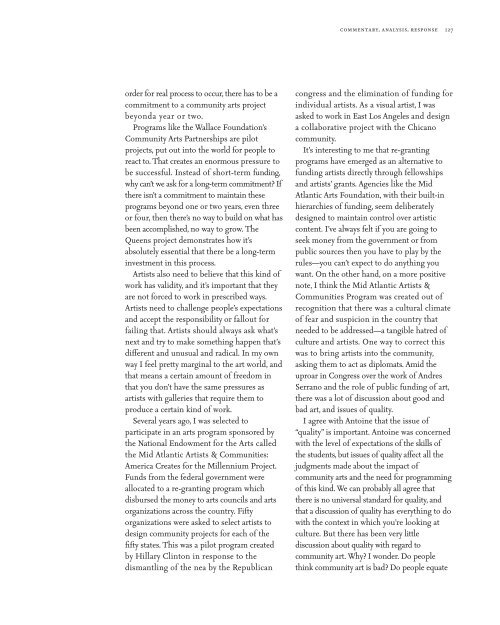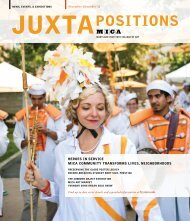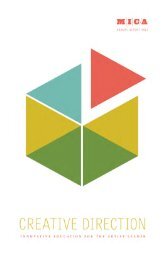art/vision/voice - Maryland Institute College of Art
art/vision/voice - Maryland Institute College of Art
art/vision/voice - Maryland Institute College of Art
Create successful ePaper yourself
Turn your PDF publications into a flip-book with our unique Google optimized e-Paper software.
order for real process to occur, there has to be a<br />
commitment to a community <strong>art</strong>s project<br />
beyonda year or two.<br />
Programs like the Wallace Foundation’s<br />
Community <strong>Art</strong>s P<strong>art</strong>nerships are pilot<br />
projects, put out into the world for people to<br />
react to. That creates an enormous pressure to<br />
be successful. Instead <strong>of</strong> short-term funding,<br />
why can’t we ask for a long-term commitment? If<br />
there isn’t a commitment to maintain these<br />
programs beyond one or two years, even three<br />
or four, then there’s no way to build on what has<br />
been accomplished, no way to grow. The<br />
Queens project demonstrates how it’s<br />
absolutely essential that there be a long-term<br />
investment in this process.<br />
<strong>Art</strong>ists also need to believe that this kind <strong>of</strong><br />
work has validity, and it’s important that they<br />
are not forced to work in prescribed ways.<br />
<strong>Art</strong>ists need to challenge people’s expectations<br />
and accept the responsibility or fallout for<br />
failing that. <strong>Art</strong>ists should always ask what’s<br />
next and try to make something happen that’s<br />
different and unusual and radical. In my own<br />
way I feel pretty marginal to the <strong>art</strong> world, and<br />
that means a certain amount <strong>of</strong> freedom in<br />
that you don’t have the same pressures as<br />
<strong>art</strong>ists with galleries that require them to<br />
produce a certain kind <strong>of</strong> work.<br />
Several years ago, I was selected to<br />
p<strong>art</strong>icipate in an <strong>art</strong>s program sponsored by<br />
the National Endowment for the <strong>Art</strong>s called<br />
the Mid Atlantic <strong>Art</strong>ists & Communities:<br />
America Creates for the Millennium Project.<br />
Funds from the federal government were<br />
allocated to a re-granting program which<br />
disbursed the money to <strong>art</strong>s councils and <strong>art</strong>s<br />
organizations across the country. Fifty<br />
organizations were asked to select <strong>art</strong>ists to<br />
design community projects for each <strong>of</strong> the<br />
fifty states. This was a pilot program created<br />
by Hillary Clinton in response to the<br />
dismantling <strong>of</strong> the nea by the Republican<br />
commentary, analysis, response 127<br />
congress and the elimination <strong>of</strong> funding for<br />
individual <strong>art</strong>ists. As a visual <strong>art</strong>ist, I was<br />
asked to work in East Los Angeles and design<br />
a collaborative project with the Chicano<br />
community.<br />
It’s interesting to me that re-granting<br />
programs have emerged as an alternative to<br />
funding <strong>art</strong>ists directly through fellowships<br />
and <strong>art</strong>ists’ grants. Agencies like the Mid<br />
Atlantic <strong>Art</strong>s Foundation, with their built-in<br />
hierarchies <strong>of</strong> funding, seem deliberately<br />
designed to maintain control over <strong>art</strong>istic<br />
content. I’ve always felt if you are going to<br />
seek money from the government or from<br />
public sources then you have to play by the<br />
rules—you can’t expect to do anything you<br />
want. On the other hand, on a more positive<br />
note, I think the Mid Atlantic <strong>Art</strong>ists &<br />
Communities Program was created out <strong>of</strong><br />
recognition that there was a cultural climate<br />
<strong>of</strong> fear and suspicion in the country that<br />
needed to be addressed—a tangible hatred <strong>of</strong><br />
culture and <strong>art</strong>ists. One way to correct this<br />
was to bring <strong>art</strong>ists into the community,<br />
asking them to act as diplomats. Amid the<br />
uproar in Congress over the work <strong>of</strong> Andres<br />
Serrano and the role <strong>of</strong> public funding <strong>of</strong> <strong>art</strong>,<br />
there was a lot <strong>of</strong> discussion about good and<br />
bad <strong>art</strong>, and issues <strong>of</strong> quality.<br />
I agree with Antoine that the issue <strong>of</strong><br />
“quality” is important. Antoine was concerned<br />
with the level <strong>of</strong> expectations <strong>of</strong> the skills <strong>of</strong><br />
the students, but issues <strong>of</strong> quality affect all the<br />
judgments made about the impact <strong>of</strong><br />
community <strong>art</strong>s and the need for programming<br />
<strong>of</strong> this kind. We can probably all agree that<br />
there is no universal standard for quality, and<br />
that a discussion <strong>of</strong> quality has everything to do<br />
with the context in which you’re looking at<br />
culture. But there has been very little<br />
discussion about quality with regard to<br />
community <strong>art</strong>. Why? I wonder. Do people<br />
think community <strong>art</strong> is bad? Do people equate
















